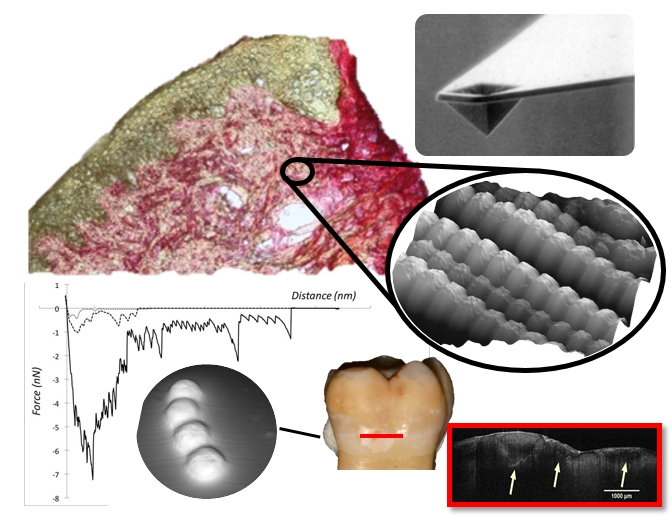The research carried out in my group is highly translational, focussing on the application of basic science concepts and innovative technologies to advance the knowledge, understanding and diagnostics of human health and diseases, including those associated with oral health.

Investigating the mechano-biology of tissues at the nanoscale is paramount to establish not only the link between their forms and functions, but also the inception of several diseases and disorders.
With expertise in nanometrology and especially Atomic Force Microscopy (AFM) and nanomechanics, my research group focusses primarily on “Mechano-Biology for Healthcare at the microns and sub-microns scale” in research fields related to ageing, connective and mineralised tissue disorders and finally bacteriology.
Current research themes
- Quantitative Nano-Histology
- Living-probe
- Optical Coherence Tomography (OCT) and ultrasound as a diagnostics tool for dentistry
- Conservation and cultural heritage
Atomic Force Microscopy expertise
AFM is among the most recent major breakthroughs in microscopy and was commercially introduced in 1989.
Perhaps still a specialist tool in life science applications, its use in the pharmaceutical industry is likely to increase.
AFM instruments, part of a broader range known as scanning probe microscopy (SPM), work using a mechanical beam known as a cantilever. This has a probe at its end used to scan the sample surface.
AFM measures a range of different forces between the probe tip and the surface. As the tip comes close to the surface, forces between the two make the cantilever bend and that motion is detected by a laser.
- You can learn more in A close look at microscopy by the Royal Society of Chemistry.
“One of the biggest challenges for AFM is to make the platform more accessible to non-experts,’ comments Laurent Bozec, senior lecturer in biophysics and tissue engineering at the Eastman Dental Institute at University College London in the UK. For instance, a range of variables such as noise level and resolution have to be controlled by the operator. This means manually pressing a set of different buttons on the machine to get the desired image of the sample. Bozec, however, wants it to be usable by non-specialists such as clinicians in hospitals.”